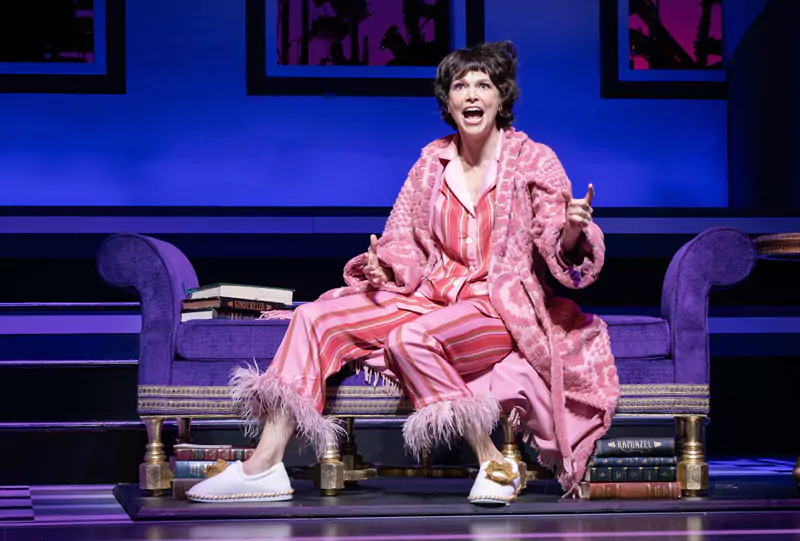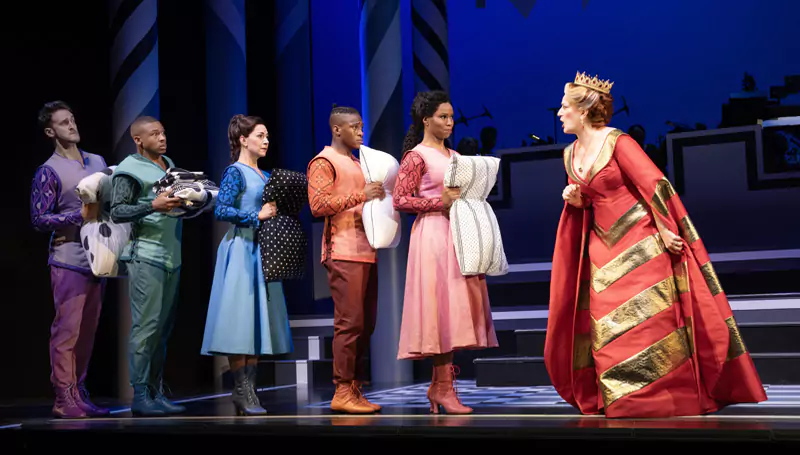“Once Upon a Mattress”, Hudson Theatre
Glenda Frank in New York
4 November 2024
I was seduced by theatre in part because of the many moving parts that allow each new production multiple balances. Musical theatre is an even more complex machine, and in the hands of a clever director, a kooky old work can become a contemporary hit. The 1959 musical Once Upon a Mattress with music by Mary Rodgers, lyrics by Marshall Barer and book by Jay Thompson, Marshall Barer and Dean Fuller, now at New York’s oldest theatre was directed by Lear deBessonet (the next artistic director of Lincoln Center Theater) who also directed it off-Broadway at City Center’s Encores series. This is a cheery, chunky, chuckling, sometimes startling comic wonder thanks to that synergy.

Sutton Foster as Princess Winnifred.
Photo credit: Joan Marcus.
The romantic comedy is based on “The Princess and the Pea,” a children’s story by Hans Christian Andersen with echoes of a skewed Calderón’s La vida es sueño, but the adaptation (Amy Sherman-Palladino, creator of The Marvelous Mrs. Maisel) has contemporary nuances and taps the plentiful tool box of classical comedy. At the heart of the production are three performers whose characters are locked into an intergenerational struggle. Queen Aggravain (Ana Gasteyer), the blocking agent, is finally in charge. Her husband (good performance by David Patrick Kelly) can’t rule because he is under a curse of silence (with allegorical echoes of the henpecked husband). To retain her power, she infantilizes her son, Prince Dauntless (Michael Urie), disparaging each of her son’s promising marital candidates. Although Aggravain is the old, negative stereotype of the bullying, power intoxicated female leader, in Gasteyer’s impressive performance, the depiction skirts the offensive.
As Dauntless, Urie is appealing in his innocence and palpable longing. Like young adults everywhere, he wants to break free but doesn’t know how until Sir Harry (Will Chase) brings Princess Winnifred the Woebegone (Sutton Foster) to the castle. She looks like a homeless waif, calls herself Fred, broadly adores the prince at first glance and most importantly, she can do things. “She swam the moat!” – one of Dauntless’s favorite refrains — to get to him.

Ana Gasteyer and Sutton Foster (foreground).
Photo credit: Joan Marcus.
The gender transposition in this Romeo and Juliet situation is part of the fun. Fred is a lightning rod for the Queen’s undisguised disapproval. But despite looking as though she has lived in a swamp, she is emotionally open and unassuming and modest (“Shy” is one of her funnier songs). What could be more appealing to a repressed prince and a modern audience? Some performers push the audience away emotionally so that we can focus on their enormous talent. Some, like Foster, Urie and Gasteyer under deBessonet’s direction, invite us to get closer, to ride the emotions even when they belt out show-stopping numbers.
Foster is having fun with the role. Hyperbole is one of her favorite tools and costume designer Andrea Hood has her enter almost recognizable in debris and dirt. She cleans up well, but she is sleepless with what we are told is one pea under her 20 mattresses, the Queen’s vicious attempt to disprove her lineage. Foster fidgets, flails and almost falls off the tower of bedding in a beautiful series of acrobatics. Just when you think she’ll stop, she produces a broader fumble for us. The Queen is stunned when Fred complains about being black and blue the next morning. (The disclosure of her restlessness (no spoiler alert here) shows how much the palace staff love her.
Once upon a Mattress is a great deal more than the Sutton Foster show; she is at the top of her game, but she shares the spotlight. And then there is the uneven script, music and choreography (by Lorin Latarro) which at times rises to its own star level; hence, the synergy. The surprise of a captivating dance routine or a beautifully turned phrase adds sparkle, a sense of completion to the production that is wonderful because it’s unexpected.
I’m sure in the gender-stereotyping 1950s audiences had a very different attitude towards Fred, which may even have been part of the original comic concept. But today she could be Simone Biles or Maria Sharapova coming to rescue the prince, which evokes different emotions. It’s good to contemplate both variations. Queen Aggravain’s name indicates we were to mock her as vain and deluded. Great to contemplate the change!









